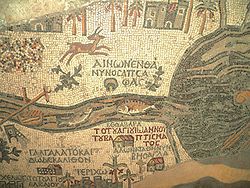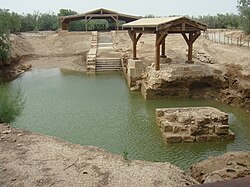Bethabara

| UNESCO World Heritage Site | |
|---|---|
 Al-Maghtas ruins on the Jordanian side of the Jordan River are the location for the Baptism of Jesus and the ministry of John the Baptist. | |
| Location | Balqa Governorate Jordan |
| Criteria | Cultural: iii, vi |
| Reference | 1446 |
| Inscription | 2015 (39th Session) |
Bethabara (/bɛ[invalid input: 'th']ˈæbərə/ beth-AB-ər-ə; בית עברה; bēth‛ăbhārāh; Βηθαβαρά; Bēthabará; "house of the ford, place of crossing") is the name used by some versions of the New Testament for the site "beyond (i.e. east of) the Jordan" where John the Baptist preached and performed baptisms, where he met with a group of priests and Levites sent by the Pharisees to investigate his ministry, and where he baptised Jesus.[1] The name "Bethabara" also appears on the 6th-century Madaba Map and in the Talmud.
The most likely location of Bethabara is Al-Maghtas in Jordan.
Traditions based on interpretations of the scriptural texts connect the site with two other miracles: the crossing of the River Jordan, whose waters were divinely restrained, by the Israelites under the command of Joshua (Joshua 3Template:Bibleverse with invalid book); and Prophet Elijah being taken to heaven by chariots of fire (2 Kings 2:9, 11Template:Bibleverse with invalid book). Bethabara is also mentioned as the location of Jesus' baptism in The Book of Mormon, as foretold by the first prophet in the Book of Mormon, Lehi, approximately 600 years before Jesus' birth.
Attempts at identifying Bethabara
Different ancient manuscripts containing the Gospel of John are using two different names, either Bethabara or Bethany, for the place where John was baptising "with water" and where he named Jesus "the Lamb of God, which taketh away the sin of the world."(John 1:28–29Template:Bibleverse with invalid book)
According to the King James Version (following Textus Receptus of the New Testament, which follows the New York and Moscow uncials, corrected forms of Ephraemi and Athos, along with uncial fragments from St Petersburg, Paris, minuscule 1, and family 13, backed up by Eusebius, Cyril, some Byzantine texts and lectionaries, and the Curetonian Old Syriac, Aramaic Peshitta, Armenian, and Georgian manuscripts, among others,[2] "Bethabara" is the place where John the Baptist baptized those who came to hear him preach. The word only appears once in the New Testament, at John 1:28), and is used in modern texts based on the King James Version, in the Geneva Bible and in the Jubilee Bible 2000. However, the same verse in the Revised Version, the New International Version and the English Standard Version reads "Bethany".[3] It is distinguished in some text versions from the Bethany of Lazarus and his sisters with a footnote stating that these are distinct locations.[4]
The reading Bethabara became current owing to the advocacy of both Origen (3rd century) [5] and John Chrysostom (4th century),[6] and that same Bethabara is attested in both the 6th-century Madaba Map [7] and in the Jewish Talmud.[8]
G. A. Smith suggests in his "Atlas of the Historical Geography of the Holy Land" (HGHL; 1915) that Bethany (house of the ship) and Bethabara (house of the ford) are names for the same place.
Bethabara has also been identified with Beth-barah, which, however, was probably not on the Jordan River but among the streams flowing into it (Judges 7:24).
The Greek Septuagint Codex Vaticanus (LXXB) reads, Baithabara for Hebrew Masoretic Text Bēth-‛ărābhāh, one of the cities of Benjamin (Joshua 18:22). If this is correct, the site is in Judea.
Another possible solution is the corruption of the name into Bethany and Bethabara, the name having the consonants n, b and r after Beth. In Joshua 13:27 (Septuagint, Codex Vaticanus) we find, Baithanabra for Bethnimrah (Massoretic Text), and Sir George Grove in Dictionary of the Bible (arts. "Bethabara" and "Beth-nimrah") identifies Bethabara and Beth-nimrah. The site of the latter was a few miles above Jericho (see Beth-nimrah), immediately accessible to Jerusalem and all Judea (compare Matthew 3:5; Mark 1:5). This view has much in its favor.
George Frederick Wright observes: "The traditional site is at the ford east of Jericho; but as according to John 1:29, John 1:35, John 1:43 it was only one day's journey from Cana of Galilee, while according to John 10:40; John 11:3, John 11:6, and John 11:17, it was two or three days from Bethany, it must have been well up the river toward Galilee. Conder discovered a well-known ford near Beisan called Abarah, near the mouth of the valley of Jezreel. This is 20 miles from Cana and 60 miles from Bethany, and all the conditions of the place fit in with the history." However, none of the references in John's gospel actually specifies how long it took anyone to get from any of the places mentioned to any of the other places mentioned, leaving it a matter of speculation.
Archaeological discoveries
In the late 1990s, when mine clearing operations east of the Jordan enabled archaeological digs to unearth an ancient church marking baptism on a site where the Jordan River flowed in the first century, matching the place marked on the Madaba map. The local Arabic name of the site is Al Maghtas, "the immersion/baptism". This rapidly led to a growing consensus among archaeologists, scholars and church leaders that this site, just east of the Jordan River and slightly north of the place where it empties into the Dead Sea, is most likely to be the place where John the Baptist was baptizing.[9][10]
See also
- Ænon, a baptism site mentioned in the Gospel of John
- Baptism of Jesus
- Chronology of Jesus
- Ministry of Jesus
- New Testament places associated with Jesus
- Qasr el Yahud
References
- ^ John 1:28–29
- ^ Cited in The Greek New Testament, 4th ed. (1983)
- ^ S. F. Hunter (1939). "Bethabara". International Standard Bible Encyclopedia (ISBE). Retrieved 20 March 2015.
(British and American) (with Tischendorf, Westcott and Hort, The New Testament in Greek following Codex Sinaiticus, Codex Vaticanus, Codex Alexandrinus, Codex Ephraemi)
{{cite web}}: Unknown parameter|editors=ignored (|editor=suggested) (help) - ^ See John 1:28 in the Contemporary English Version and Jerusalem Bible
- ^ Bethany Beyond the Jordan - Catholic Encyclopedia article
- ^ Bruce Metzger, Textual Commentary on the Greek New Testament, 2nd ed. (1994), 171 and n. 5.
- ^ Harper's Bible Dictionary (1985), 105
- ^ Raymond Brown, Gospel According to John I-XII, Anchor Bible (1968), 44-45.
- ^ "The Discovery of Elijah's Hill and John's Site of the Baptism, East of the Jordan River from the Description of Pilgrims and Travellers | Waheeb | Asian Social Science". Ccsenet.org. 2012-06-29. Retrieved 2015-04-29.
- ^ "The Discovery of Bethany Beyond the Jordan River (Wadi Al-Kharrar)". Journals.ju.edu.jo. Retrieved 2015-04-29.
External links
![]() Media related to Bethabara at Wikimedia Commons
Media related to Bethabara at Wikimedia Commons
- The baptism site of Jesus in Jordan. Religious and political building of a Christian pilgrimage site (PhD thesis) [1]
- The Baptism of Christ - Uncovering Bethany beyond the Jordan - 47 min Documentary
- The Baptism of Jesus Christ: Uncovering Bethany beyond the Jordan. Full film (Authorized by content owners.)
